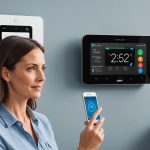Optimizing Smart Home Setup
Fine-tuning your smart home optimization can significantly enhance your living space’s efficiency. Start by understanding device compatibility to ensure a harmonious ecosystem. Not all devices communicate well, so it’s crucial to verify compatibility to prevent connectivity issues. A mismatch can cause frustration and limit home automation strategies.
Setting up devices in key areas like your living room and kitchen can optimize functionality. In living rooms, smart speakers can control lighting or television, while kitchens benefit from devices like smart fridges or voice-activated assistants, which help manage cooking tasks.
Additional reading : Maximize Your Smartphone’s Capabilities: The Definitive Handbook for Augmented Reality Expertise
Ensuring stable wireless connections is pivotal for seamless operation. Devices should be within the router’s range, avoiding obstructions that weaken signals. In highly obstructed areas, consider investing in mesh networks or range extenders to maintain strong connections throughout the home.
For smart home optimization, device connectivity must be reliable to support desired automation strategies. This ensures a system that responds efficiently to your commands, setting the stage for a truly automated dwelling. Ultimately, understanding these core elements puts you on the right track to transforming your home into a smart, integrated ecosystem.
Have you seen this : Elevate Your Home’s Ambiance: Harness Advanced Smartphone Technology for Smart Lighting Mastery
Effective Smartphone Applications for Device Control
As smart homes become increasingly sophisticated, smartphone control is essential for managing myriad devices seamlessly. Selecting the right smart home apps can elevate your device management experience to a new level of ease and efficiency. These apps serve as the digital command centers of modern homes, offering unparalleled convenience.
Top Smartphone Applications
When exploring top smartphone applications, consider those offering broad compatibility with multiple devices and platforms. Some of the leading device management apps are designed to integrate smoothly, ensuring you command all aspects of your smart home through a single interface. These applications generally support controlling lights, thermostats, cameras, and more, providing a cohesive ecosystem.
Features to Look for in Smart Home Apps
The success of a smart home app depends heavily on its features. Look for those providing real-time monitoring, customizable automation routines, and remote access. These features not only enhance functionality but ensure that your home responds intelligently to your lifestyle. Security settings, like secured login and encrypted data transfer, are crucial for protecting smart home optimization efforts.
User Experience: Navigation and Interface
A delightful user experience is paramount. Opt for apps with intuitive navigation and a clear interface. This not only simplifies managing connected devices but maximizes the effectiveness of your home automation strategies, making daily interactions effortless and enjoyable.
Automation and Integration Techniques
Customising smart home automation can transform daily routines into effortless experiences. Begin by creating personalised automated routines tailored to match specific activities like waking up or returning home. For instance, you might schedule lights to turn on and a coffee maker to start brewing at the specified hour, ensuring a smooth start to your day.
Utilise voice assistants for hands-free control, streamlining interactions with your devices. Devices such as Amazon Alexa and Google Home can execute commands like adjusting the thermostat or playing music with just a phrase, reducing the need for manual operation.
Achieving optimal functionality involves integrating multiple devices within your smart home ecosystem. This integration allows for cohesive management, where devices communicate and collaborate seamlessly. For example, a motion sensor can trigger lighting adjustments or security cameras to activate, enhancing safety and convenience.
By focusing on these techniques, your smart home can deliver not just a high level of convenience but also efficiency in energy usage, thus making your home life more manageable. Prioritising device integration and automation will ultimately lead to a sophisticated but simple living environment where technology works synergistically to adapt to your lifestyle.
Troubleshooting Common Smart Home Issues
Navigating the intricacies of a smart home can sometimes lead to device connectivity issues and other common problems. By efficiently addressing these, you can maintain a seamless and harmonious smart ecosystem.
Identifying Common Issues
The usual culprits often revolve around connectivity problems. Devices may fail to connect due to distances exceeding the router’s range or network interference. A straightforward approach to diagnose these issues involves checking your device’s Wi-Fi signal strength. If weak, repositioning the router or the affected device might solve the issue. Operational hiccups could also arise from outdated firmware. Ensuring all devices are updated regularly can preempt common performance downfalls.
Step-by-Step Troubleshooting Guide
Begin troubleshooting by restarting affected devices and resetting the Wi-Fi router. This simple step often resolves connectivity glitches. Should the problem persist, verify device settings, ensuring each is on the correct network. When the basic steps fall short, delve into manufacturer guidelines for model-specific advice.
When to Seek Professional Help
If all attempts prove futile, professionals might need to step in. Persistent connectivity issues, unexplained operational failures, or irregular device behaviour often signal this necessity. Skilled technicians can diagnose deeper network or device-specific problems, restoring your smart home to full functionality.
Security Best Practices for Smart Homes
As our homes get smarter, ensuring smart home security becomes paramount. Adopting robust security measures protects both your devices and your privacy. One foundational step is changing default passwords on all devices. Default settings are often publicly known, making them susceptible to attacks. Instead, create strong, unique passwords to fortify device access.
Device protection is further bolstered by enabling two-factor authentication (2FA), adding an extra security layer. With 2FA, even if a password is compromised, a secondary verification (e.g., a text code) is required before access is granted. This significantly enhances the security threshold against unauthorized intrusions.
Regular firmware updates are crucial in maintaining data privacy as they patch potential vulnerabilities. Manufacturers release updates to fix security gaps that could be exploited by malicious entities. Keeping your devices updated ensures compliance with the latest security protocols.
Monitoring network activity is another key practice for identifying unauthorized access attempts. Many smart home routers now offer the functionality to view connected device logs, providing insights into potential security threats. By keeping a vigilant eye on your network, you can quickly detect and respond to any suspicious activities, maintaining the integrity of your smart home ecosystem.
Future Trends in Smart Home Technology
Embracing smart home trends often offers a glimpse into the future of living conveniences and efficiencies. As technology evolves, innovative ways to control and automate our homes continue to emerge.
Innovations in Smart Home Control
Looking ahead, emerging devices are set to revolutionise how we interact with our homes. These innovations extend beyond voice commands and app controls, including gesture-based systems and context-aware technology. Such advancements promise smoother interactions and heightened personalisation, creating a more intuitive living environment.
Trends in Connectivity and Interoperability
The future points to a world where connectivity and interoperability are paramount. Devices will increasingly communicate through standardised protocols, ensuring seamless integration across varied brands. This trend will lessen compatibility hurdles, fostering a truly connected ecosystem. Smart hubs may become pivotal, serving as central nodes that simplify managing numerous devices across different platforms.
Sustainability in Smart Home Devices
Sustainability is becoming essential. As future technology progresses, there’s a focus on eco-friendly designs and energy-efficient appliances. From solar-powered devices to smart energy management systems, the goal is to diminish ecological footprints. This sustainability shift in smart home devices aligns with global environmental efforts, enhancing not only home efficiency but also conserving resources.











